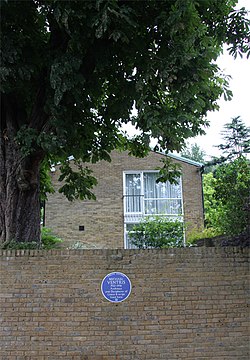Michael Ventris
| Michael Ventris | |
|---|---|

Ventris's home, 1952–1956, which he and his wife, Lois, also an architect, designed
|
|
| Born |
12 July 1922 Wheathampstead, Hertfordshire |
| Died | 6 September 1956 (aged 34) Hatfield |
| Residence | 19 North End, Hampstead, London NW3, a home designed by Ventris |
| Citizenship | United Kingdom |
| Nationality | British |
| Fields | Architecture, Archaeology, Linguistics |
| Alma mater | Architectural Association School of Architecture |
| Known for | Decipherment of Linear B |
| Influences | Arthur Evans, Alice Kober, John Chadwick, Emmett Bennett |
| Influenced | Historiography of Aegean civilization |
| Notable awards | University of Uppsala Honorary Doctorate, 1954 Order of the British Empire, 1955 |
| Spouse | Lois (Knox-Niven) Ventris |
Michael George Francis Ventris, OBE (/ˈvɛntrɪs/; 12 July 1922 – 6 September 1956) was an English linguist and architect who, along with John Chadwick and Alice Kober, deciphered Linear B, a previously unknown ancient script discovered at Knossos by Arthur Evans. A student of languages, Ventris had pursued the decipherment as a vocation since his adolescence. After creating a new field of study, Ventris died in an automobile accident a few weeks before the publication of his definitive work, Documents in Mycenaean Greek.
Ventris was born into a traditional army family. His father, Edward Francis Vereker Ventris, reached the rank of lieutenant colonel in the Indian Army; however, his career was suddenly brought to an end, as he contracted tuberculosis and retired. His grandfather, Francis Ventris, was a major-general who ended his career as Commander of British Forces in China. During his time in England, Edward Ventris met and married Anna Dorothea Janasz (Dora), the daughter of a wealthy jewish immigrant landholder from Poland. Michael Ventris was their only child.
Health became an issue early on in Ventris's life, as he developed at a young age chronic bronchial asthma. The family then moved to Switzerland for eight years, seeking a clean and healthy environment for their child. A number of health clinics and spas catered to the physical well-being of Ventris, constantly observing his well-being. Ventris started school in Gstaad, where classes were taught in French and German. He soon was fluent in both languages and showing proficiency for Swiss German. He was capable of learning a language within a matter of weeks, which allowed him to acquire fluency in a dozen languages. His mother, of Polish descent, often spoke to him in her own tongue, in which he was fluent by the age of eight. At this time, he was reading Adolf Erman's Die Hieroglyphen in German.
...
Wikipedia
